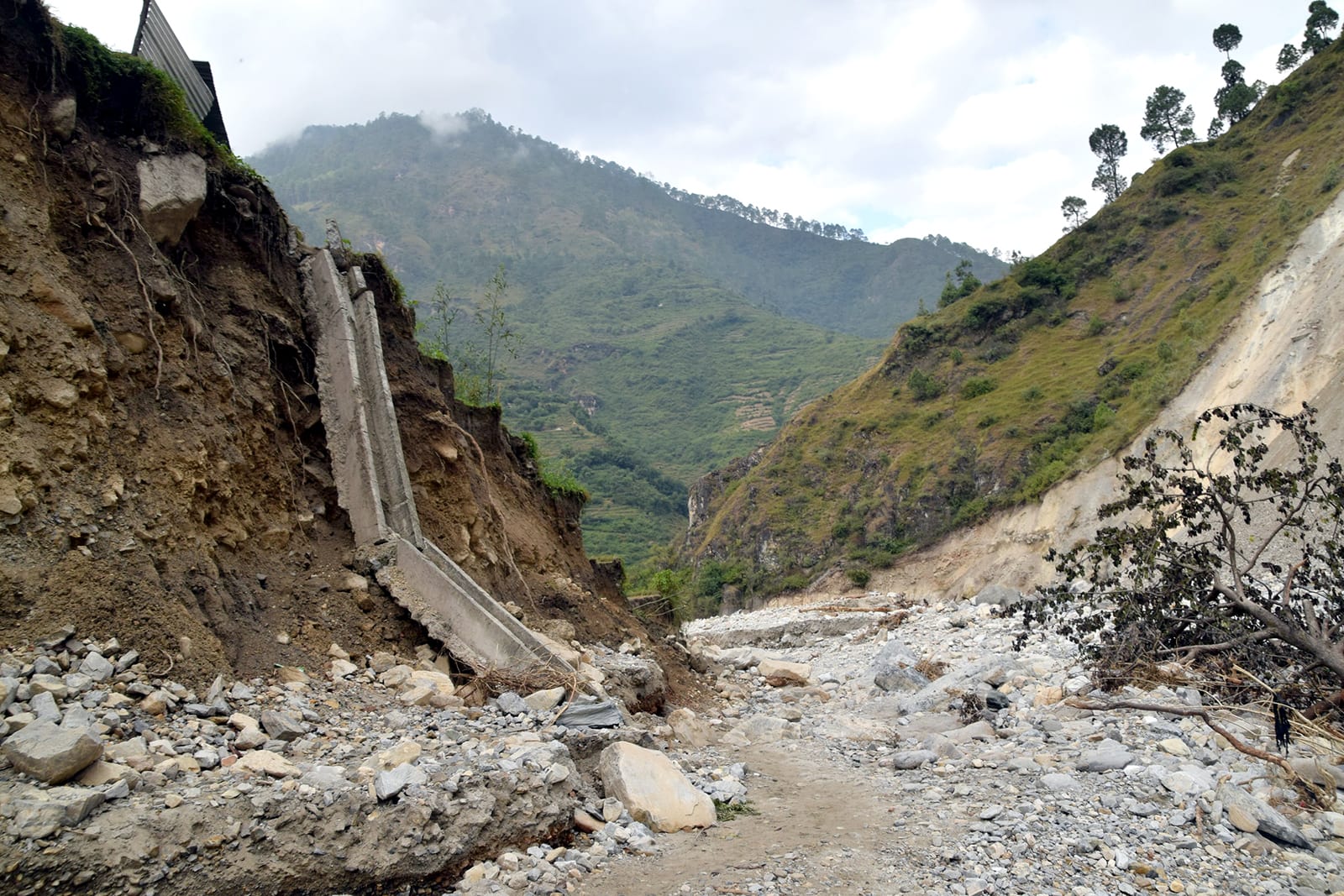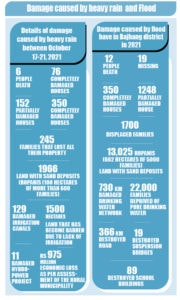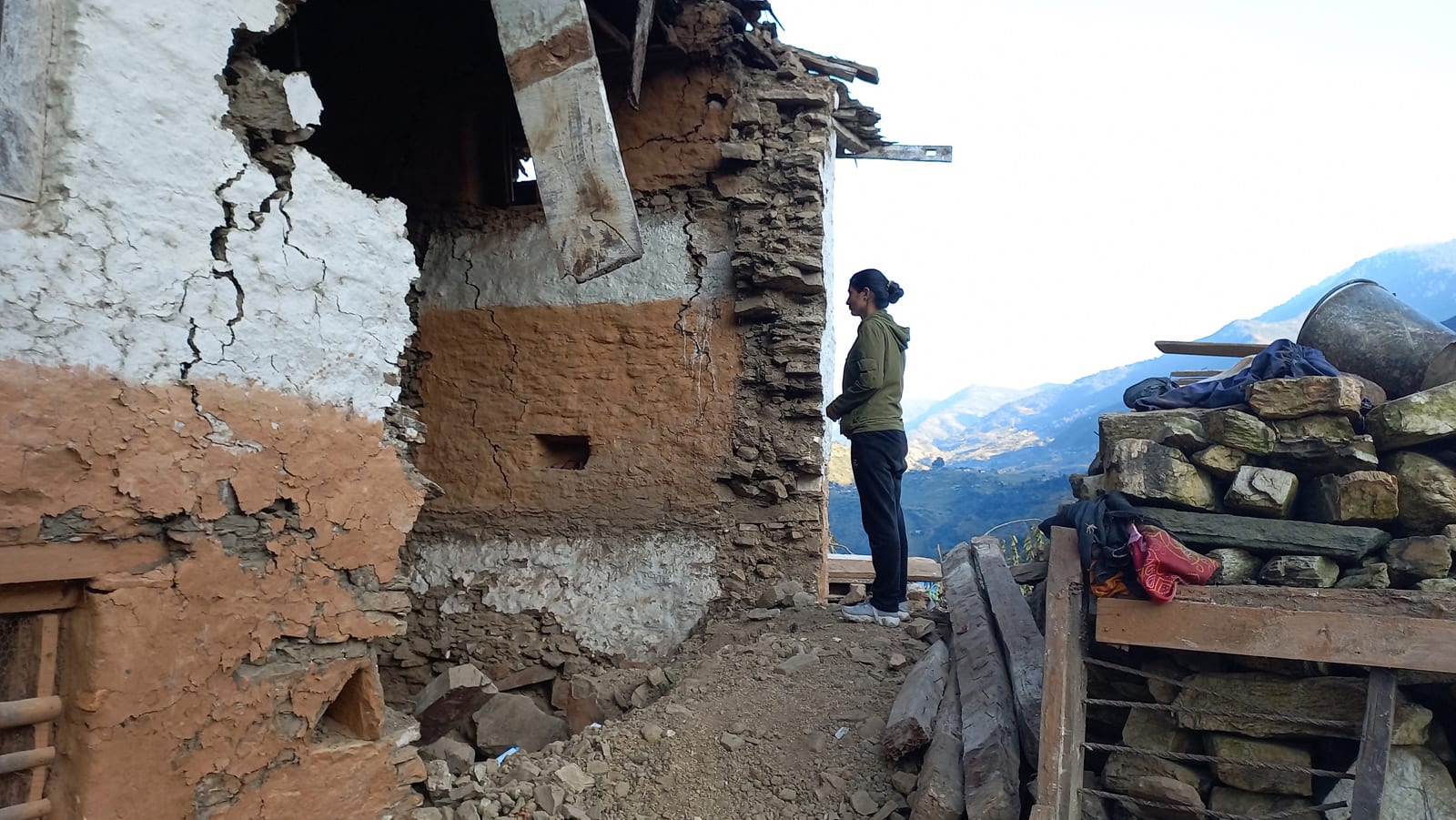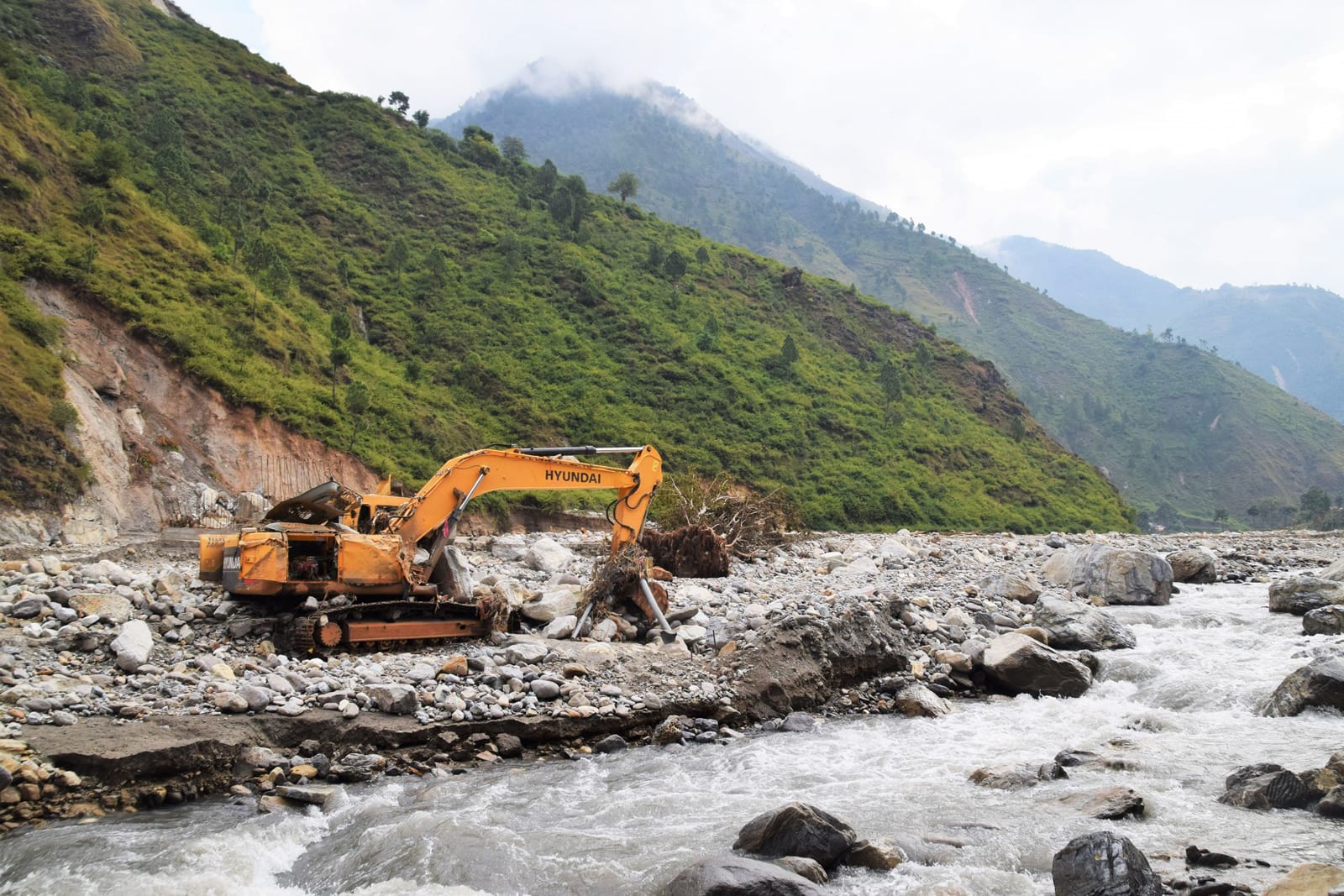A beautiful village in Bajhang has become desolate as officials neglected laws and regulations and even ignored warnings of experts. This is the story of the destruction of heritage, community, and the environment due to unrestrained exploitation of nature in the rush for ‘development’.
Basant Pratap Singh |CIJ, Nepal
Khaptadchhanna Rural Municipality of Bajhang is rich in natural resources and fertile land. The Khaptad area uphill and its fields are not only beautiful but are also a source of livelihood for residents. Even during periods of long droughts, water from Khaptad keeps the area moist.
The rural municipality was also a model in the district due to the development of infrastructures such as schools, health institutions, electricity, and roads. Until October 2021, 11 powerhouses were in operation. Hundreds of small industries run on electricity and there was running water in every house. With the expansion of irrigation canals, more than 500 families engaged in commercial agriculture.
However, the rain that started on October 17 and continued till morning of October 21 changed this rural municipality. Floods and landslides that followed left six people dead and 185 families displaced. A total of 1,966 ropanis (100 hectares) of land belonging to more than 600 families became barren. A total of 245 farmer families became landless.
The destruction caused by floods and landslides was not limited to this. Sources, intakes, reserve tanks, and pipelines of 66 drinking water projects were destroyed. A total of 129 irrigation canals were swept away, and 11 micro-hydro projects were flooded. Schools, community buildings, health posts, bridges, and 26 water towers were also razed. The green fields turned into lifeless piles of sand.

Irrigation canal collapsed after landslide. All pics: Basanta Pratap Singh
The rural municipality estimates that property worth around Rs one billion was lost during the period. The floods and landslides affected not only Khaptadchhanna, but the entire district.
According to the District Disaster Management Committee’s ‘Disaster Preparedness and Response Plan-2075’, the district has seen at least five major floods and landslides in the last 55 years. However, the damage it suffered was much less compared to 2021.
“Nothing happened in 1982 when there was torrential rain for seven or eight days,” said Piru Kami, 65. “This year, two days of rain washed away the village.”
“it had rained continuously for two weeks in 1967. At that time, not a single stone fell from the slopes. This time it was incredible, the whole village was devastated, ” says Saurya Khati, 80.
The road to destruction’
How did Bajhang, which didn’t suffer much even when faced with heavy rains in the past, get devastated with a comparatively lower amount of rainfall? Everyone has a common answer to the question. It’s about the indiscriminately dug roads.
Environmentalists, infrastructure experts, and farmers have concluded that Bajhang suffered unimaginable destruction due to the roads built without taking into account the geography, geological conditions, and environmental risks.

” In 2000, we received 124 hours of continuous rain. Even in 2008, It rained for 96 hours. But now 50 hours of rain caused a lot of damage, ” said Chetraj Bajal, former chairman of the now defunct Bajhang District Development Committee. “We used heavy machinery to dig roads without proper surveys and designs and that proved to be a curse for us.”
When the extent of damage caused by heavy rain in 12 rural municipalities of Bajhang is analysed, it can be seen that areas where roads were constructed indiscriminately bore the most of the brunt. Some villages of Khaptadchhanna were washed away as landslides started from the roads. Landslides were reported in eight villages including Gadigaun, Musuradi and Dwali. No damage was reported in Saipal Rural Municipality which is not touched by roads.
Hemraj Joshi, former teacher of Lamatola Secondary School, says that last year’s floods and landslides have laid the foundation for a catastrophe. Even normal rain might cause flooding. “Landslides are happening all around. Several houses have been washed away, ” he said. “This year, it didn’t kill a lot of people, but we don’t know when a village will be swept away.”
Ajay Dixit, a hydrologist who has conducted on-site studies on the environment of Bajhang, also says that unimaginable damage has been caused due to indiscriminate digging of roads. Dixit says, “The destruction of Bajhang is a doing of its own people.”

A house destroyed by a landslide.
Green infrastructure expert Santosh Panthi, who has been studying the geographical, environmental, and watershed areas of Bajhang for two years, says that people’s lives have been put at risk in the name of road development. “From an engineering point of view, 95 percent of the roads here are not roads, ” he says. He said that these roads dug by non-standard back-hoe loaders have clogged the drainage of water, increased the risk of landslides, and accumulated mud and stones on the sloping terrain.
Law limited to paper
The Environment Protection Rules contain provisions to reduce the environmental damage during the construction of infrastructure . According to the law, when preparing a proposal related to development work or a project, an initial environmental examination (IEE) or environmental impact assessment (EIA) should be carried out and approval should be obtained from the concerned body.
However, local government representatives who are in a hurry to show their electorate “development” ignored this law and built roads everywhere. The Ministry of Federal Affairs and Local Development had asked the then District Development Committee about the construction of roads without environmental testing five years ago after the Center for Investigative Journalism published a report about it . “The letter was discussed once, but no reply was sent, ” said Birendra Bahadur Singh, the then information officer of the district development committee .
The master plan prepared by the then District Development Committee eight years ago mentioned that 214 kilometers of roads were required in the district. However, according to the District Coordination Committee, 223 roads (1,561 km) are being constructed in 11 municipalities.
The local and provincial governments constructing the roads have rejected instructions from the federal ministries on setting priorities and standards before building roads.
On July 3, 2018, The Sudurpaschim Provincial Disaster Management Committee decided to enact a legislation to regulate the use of heavy machinery in sensitive areas including the Chure range, after concerns were raised about their risks.
However, that piece of legislation never saw the light of day. Secretary at the Ministry of Physical Infrastructure Development, Tulsiram Bhattarai, says, “Even as the law was not enacted, we have started the practice of doing the road construction work only through the contract process and not through the consumer committees.”
Although Bhattarai claimed that the roads built by the provincial government have low environmental risk, roads built by it have pushed areas such as Gadigaun, Musuradi and Dwali to the edge. At present, the District Administration Office and the Chief Minister’s Office are working to make arrangements for the relocation and resettlement of villagers of Ambagar, Thing and Pades.
Unheeded warnings
In 2018, GeoHazard International, an international organization that studies natural disasters, released a report on the high risk of landslides caused by back-hoe loaders digging roads indiscriminately.
The report projected that landslides could occur in 3,630 places in 11 rural municipalities in the event of an earthquake bigger than seven on the Richter scale. The report, made public after a two-year study of Bajhang’s environmental and geological conditions, suggests stringent control on the use of heavy machinery.
FIAN Nepal, an NGO working in the field of right to food, had recommended taking control measures four years ago saying that landslides in Bajhang have destroyed the livelihoods of thousands of people. According to its study report, more than 5,000 ropanis (254 hectares) of arable land has been filled with landslide debris and 21,000 ropanis of 38 farms in Danahar are being filled.

A school of Khaptadchhanna washed away by the flood in Jadari Gad.
With the curse of ‘dozer development’ it’s now difficult even to get potable water said Ashok Bahadur Singh, managing director of FIAN Nepal. FIAN Nepal showed evidence to the people’s representatives that the roads were clogging the irrigation system, but they didn’t act, he said. “Indiscriminate use of back-hoe loaders is violating the right to food guaranteed by the constitution,” he said.
The extent of the problem is also evident from the statement issued by the heads of government offices in the district. On June 28, 2018 the District Agriculture Development Office, District Forest Office, District Land Conservation Office, and District Irrigation Division Office issued a statement urging the stakeholders to stop the use of heavy machinery immediately. “We have said many times that this “dozer development” could cause disasters,” they said.
Commission controversy
Various pieces of evidence show that it’s not only the hunger for development, but also the greed of commissions that is behind the blind construction of roads ignoring the law, ministry directives and circulars, district road master plans, and expert warnings.
On February 8, 2019, the federal government banned the use of back-hoe loaders in projects with a budget up to Rs 10 million. However, the local governments of Bajhang faked its papers to evade the ban.
Documents obtained using the right to information show that a back-hoe loader operator was paid money that was on paper given to workers. Even a one-year-old child was paid Rs 17,000 for working for a month. Names and signatures of people not living in the village were also found.
Some people’s representatives have used their own back-hoe loaders for road construction. Some people’s representatives have been accused of awarding contracts to relatives and raking up commissions of upto Rs 1.5 million.

A dozer washed away by the flood in the Kuche river of Khaptad Channa.
According to the ‘Road Construction and Risk Reduction in Nepal’s Political Economy’ report published in April 2021 by Oxford Policy Management and The Policy and Institution Facility, 33 percent of people’s representatives across the country were directly involved in construction of roads. Experts say that the number of people’s representatives operating back-hoe loaders is much higher than this.
The extent of the problem could be assessed by examining the events that led to the transfer of the chief district officer who tried to take action against the indiscriminate use of back-hoe loaders.
Chief District Officer Suresh Sunar, who came to Bajhang on March 1, 2019, wrote to all the local governments to stop the use of heavy machinery on the development of roads being built without prior feasibility, design, and environmental impact studies. Following this, district-level members of parliament, local people’s representatives, former lawmakers, former ministers, and party leaders approached the Ministry of Home Affairs demanding Sunar’s transfer.
As a result: On August 30, 2019, the Ministry of Home Affairs transferred Sunar to Morang as assistant chief district officer. Then Home Ministry Secretary Prem Kumar Rai admitted that Sunar had to be transferred after he could not resist pressure from the people’s representatives.
Jay Prithvi Municipality, Thalara, Talkot and Chhabis Pathibheri Rural Municipalities had prepared their own road construction guidelines two years ago. But they have failed to implement them due to pressure from interest groups.
The report by Oxford Policy Management revealed that roads are being built for economic gain without geological and environmental studies and people’s representatives, employees, businessmen and party workers are involved in it. The risk of landslides is increasing every year as the practice of road construction continues with the aim of providing roads to every household. To address the situation, all three levels of government, people ‘s representatives, non-governmental and community-based organizations, experts, researchers, the private sector and multi-stakeholders should all take the initiative, the report said.
The people’s representatives and construction entrepreneurs should be sensitive towards making road construction work environment friendly. They emphasized the need to build roads of strategic importance by adhering to established norms , procedures, and standards instead of constructing roads indiscriminately. However, despite the devastation caused by the powerful interest groups and opaque economic politics associated with the development of roads, there aren’t any signs that the three tiers of government have opened their eyes to the reality in front of them.



